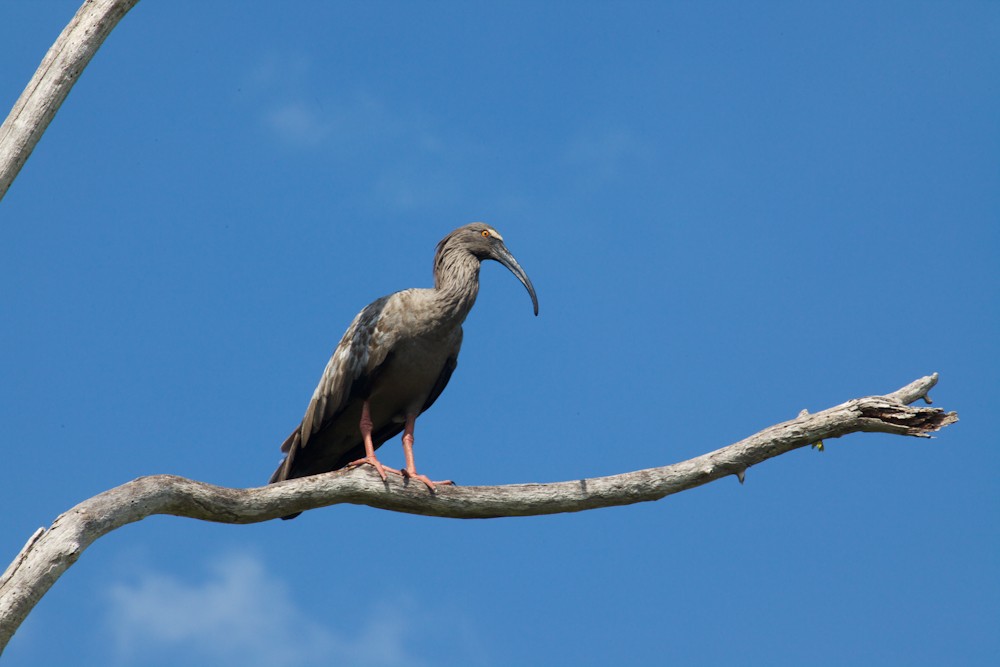Plumbeous Ibis
A species of South American Grassland Ibises Scientific name : Theristicus caerulescens Genus : South American Grassland Ibises
Plumbeous Ibis, A species of South American Grassland Ibises
Botanical name: Theristicus caerulescens
Genus: South American Grassland Ibises
Content
Description General Info
Description
The plumbeous ibis Theristicus caerulescens, also formerly called the blue ibis, is a large distinctive ibis species endemic to parts of central South America. 
Size
76 cm
Nest Placement
Ground
Feeding Habits
Plumbeous Ibis specializes in molluscs but also eats aquatic invertebrates, snails, frogs, and small reptiles. Solitary or in small flocks, plumbeous Ibis forages by probing shallow waters, often accompanied by similar species. Parents regurgitate food for chicks who trigger feeding by bill-prodding.
Habitat
The plumbeous Ibis favors open lowland habitats within central South America, thriving in environments such as grassy wetlands, marshes, and shallow lakes, typically below 600m elevation. It adapts well to anthropogenic landscapes, including areas surrounding dams and rice fields. While it usually inhabits freshwater regions, it avoids saline and brackish waters and may engage in minor local migrations.
Dite type
Omnivorous
General Info
Feeding Habits
Bird food type
Distribution Area
The plumbeous ibis has a relatively narrow range that extends through parts of central South America. It occurs in south-western Brazil, especially in southern Mato Grosso and Rio Grande do Sul; Paraguay, especially in the Chaco and in the Paraguayan section of the Parana Basin; Uruguay; north-eastern Argentina and northern and eastern Bolivia. The northern Bolivian population is geographically isolated from the larger continuous population spanning the remaining part of this ibis's range. The westernmost part of its range extends into the Andean foothills in central Bolivia and Tucuman. In Argentina, it has been occasionally sighted as far south as the Cordoba and Buenos Aires provinces; but is non-native in these regions. Although this species appears to be relatively common, it is patchily distributed throughout its global range; being relatively abundant in some regions but less so in others. For example, it is endemic but actually uncommon in Rio Grande do Sul, but frequently occurs in the northern Lagoa dos Patos. It is relatively common in the Chaco of Paraguay, especially in the northern Chaco where large numbers of individuals occur throughout the expanses of freshwater, so that this species is considered emblematic of the wetland avifauna of this region. Conversely, it has rarely been recorded in the pampas of northern Argentina in the southernmost part of its distribution; with an occasional handful of individuals at a time having been sighted during surveys throughout the 1990s in the Laguna Melincue Ramsar Site in the southern Santa Fe Province. Its habitat largely comprises the lowland grassy wetlands of the Pantanal and the Chaco. It is found here foraging at marshes, swamps, lagoons, shallow lakes, flooded pastures, ponds and other moist ground; but also perches in tree branches near or above the water to roost. It has also been sighted in upland marshes, usually up to 600m in elevation; and at small remnant pools in desiccated lagoons and on dry grasslands. Further, this ibis commonly occurs near human habitation and other manmade features; including dams and seasonally-flooded rice fields. It is also a relatively common sight along the Transpantaneira Highway in the Pantanal of Mato Grosso. Finally, it has been recorded close to the east Brazilian coast in wet areas in the Lagoa do Peixe National Park on the peninsula separating Lagoa dos Patos from the Atlantic (Pereira & Poerschke, 2009); but probably avoids the saline and brackish waters. Individuals are usually sedentary and can remain in a specific area all year round. They have however been reported to migrate on a local scale. Circumstantial evidence from the novel presence of individuals at Incachaca Lake in the Chapare Province of Bolivia suggests that this species may migrate between the geographically separated northern Bolivian and other South American populations, and may use Incachaca as a resting place en route. Since no subspecies have been noted for this species, the world population is probably kept genetically homogenous by short migrations of individuals between the two geographically separated subpopulations. However, it remains unknown whether this species has regular migration patterns. Incidentally, the species’ discovery at Lake Incachaca was its first recorded occurrence in the cloud forest ecoregion and was also a new altitudinal record. Unlike other ibis species, the plumbeous ibis does not form large intraspecific flocks. It is mostly seen singly or in pairs, but is also more rarely seen in groups of up to six individuals. The larger groups appear to consist of two mates accompanied by their fledged juveniles. 
Species Status
Not globally threatened.
Scientific Classification
Phylum
Chordates Class
Birds Order
Pelicans and Relatives Family
Ibises and spoonbills Species
Plumbeous Ibis 